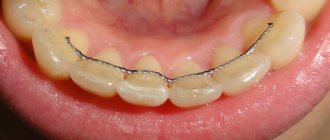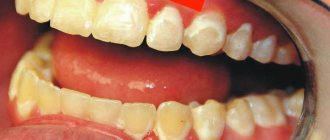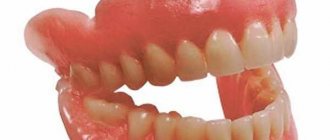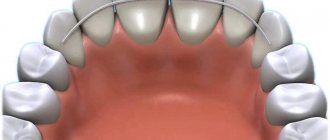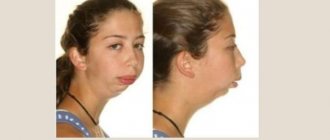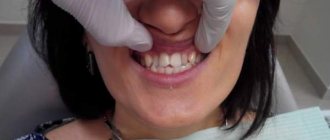Installing a braces system is the most effective method for correcting malocclusion. The period of wearing braces depends on the severity of the pathology and can range from 6 months to several years. During the treatment process, the dentition is subjected to pressure and mechanical stress. This is necessary to move the teeth into the correct position.
After correcting the bite with orthodontic appliances, some patients encounter problems. One of them is the mobility of dental units. Find out what to do if your tooth becomes loose after braces are removed.
Can adults get braces to correct their bite?
Anyone can correct a malocclusion, regardless of age. But in an adult, this process takes longer than in children, because skeletal growth has already stopped and hard bones are more difficult to form.
In addition, some oral health conditions may delay the installation of braces. For example, caries, periodontal disease, endocrine diseases.
Sometimes the effect of treatment is influenced by the presence of crowns and bridges. The treatment period starts from 1.5 years.
Factors influencing results
How soon it will be obvious that tooth movement has begun to occur depends on several factors:
- Degree of tooth curvature. The more pronounced the pathology is at first, the faster the first changes with braces will be noticeable. Experts note that the alignment of a tooth deviated into the oral cavity or towards the lips occurs faster than the displacement of the entire dentition in the horizontal plane, so in the second case the first results will become noticeable later.
- Age factor. The growth and development of all parts of the body occurs faster in children and adolescents, while in adults there is a natural slowdown in these processes. For this reason, it can be assumed that the younger the patient with braces, the faster the progress will appear, and the entire course will be significantly shortened.
- Individual characteristics . This parameter is associated with the health status and characteristics of the physiological processes of each person. Even people of the same age with the same pathologies and common methods for eliminating them demonstrate different dynamics, so it is very difficult to predict in advance how long it will take to wait for the first changes.
- Bracket type. Metal non-ligature braces are recognized as the most highly effective, so with them movement will be noticeable earlier. Also, the dentition reacts faster to the vestibular systems than to the lingual ones.
- Dentist qualification. The doctor's skills and knowledge allow him to attach the braces exactly as required to quickly begin activation. Deviation from the desired point of attachment of the lock by just a millimeter will greatly slow down the process and, as a result, will not allow you to achieve a perfect bite. An experienced orthodontist can choose exactly the force of pressure on the teeth at which movement will begin in the shortest possible time, but will not lead to damage to the deep structures of the jaw.
Does teeth straightening hurt?
The installation of braces itself is painless, but requires patience because it takes about an hour.
For 7-10 days, teeth may hurt when biting. The body must get used to foreign objects. In general, you live your old life, you just notice pleasant changes in yourself.
Control visits are needed to correct the process and form the correct position of the teeth. Usually after changing the arch the pain goes away within 3-7 days. It all depends on individual sensitivity.
For some, wearing braces is only unpleasant, for others, on the contrary, it is painful, and some do not feel anything.
Possible difficulties when wearing braces
In order to prevent the reverse process of correcting the bite, you should strictly follow all the rules for wearing an orthodontic appliance:
- Don't take on the role of a specialist and stop wearing removable braces on your own. Only an orthodontist can determine the duration of the retention period. This question takes into account the patient’s age, genetic predisposition, and individual characteristics of the oral cavity.
- During hygienic procedures when operating a fixed device, the set of necessary tools should be expanded. In addition to a toothbrush, it is recommended to use special brushes and dental floss.
- Plastic aligners should be removed from the mouth before each meal, otherwise they may become deformed during the chewing process.
- As an additional oral care product, it is worth using a fluoride-containing rinse, which will strengthen the structure of tooth enamel.
Professional cleaning is recommended at least twice a year.
Even significant crooked teeth can be corrected with braces. The duration of treatment depends on the complexity of the situation. Some patients wear braces for three years or even more. During this time, various not very pleasant situations may occur. Braces can rub and interfere with eating. In addition, after installation of a straightening system, teeth may hurt and become loose.
Each qualified specialist should advise the patient regarding possible problems and difficulties while wearing braces. This rarely frightens the patient, because for most the dream of a beautiful smile overshadows all problems.
Do braces make it difficult to eat?
Once installed, you will need to learn how to eat in them. This period takes on average 3-7 days.
At this time, give preference to soft and liquid foods. Cut fruits and vegetables into small pieces. Avoid fibrous and sticky foods.
Over time, you will be able to eat almost everything except Coca-Cola (can dissolve glue), hard foods (nuts, crackers, chocolate) and sticky sweets (chocolate, cookies or caramel bars). You should also not chew gum.
Prevention
In order to prevent teeth from moving apart after braces, in the case of removable aligners, you should follow the following classic recommendations of orthodontists:
- in the first six months of using the product, it should be worn 24 hours a day;
- after 6 months, throughout the year, the structure must be worn only at night;
- after a year and a half, specialists allow the mouthguard to be used every other night.
If you are wearing a metal wire, it is recommended to check the fixation of your teeth 2 times a month. To avoid relapse, you should also not neglect the above rules for using retainers.
In the video, the specialist will talk about the reasons for teeth discrepancies after the main period of treatment with braces and the need to follow the rules of the retention period.
How often should inspections be carried out?
Every 1-2 months, it all depends on the defect and the individual structure of the patient’s teeth. During the visit, the orthodontist checks the success of the treatment and sets a vector for the arch, which determines the movement of teeth in the right direction.
Missing follow-up visits may negate the effect of previous treatment. You are also required to visit a hygienist every six months.
Braces, whether external or internal, need to be worn for an average of 1.5 years. But determining more precise timing depends on the initial situation and age of the patient. Sometimes it takes 2 years to eliminate a defect.
If not noticeable
Sometimes it seems to the patient that the system is installed, time passes, but no changes are observed. You should ask your doctor questions like these without hesitation. The fact is that understanding the processes that occur with a person and complete trust in the specialist supervising the treatment are key points that ensure the success of the course. Sometimes the first results are not noticeable during a routine examination. This happens, for example, if at the first stage of bite restoration they struggle with retention. Then the results can only be assessed during an examination in the dentist’s chair or with the help of x-rays, which are performed on the direction of a specialist.
Sometimes it happens that the first results really do not appear for a long time. The specialist will definitely see this and take action. These can range from stronger archwire positioning to a complete overhaul of the treatment plan using different techniques. The latter option occurs very rarely, in approximately 1-1.5% of cases. However this happens, all conclusions are provided and deciphered to the patient, and decisions are made mutually based on the facts and options voiced by the orthodontist.
What to do if the bracket comes off?
In itself, this happens quite rarely, only in cases of severe crowding of teeth, since the arch puts a lot of pressure on the dentition and the lock falls off. Another option is if the patient is a nut or other solid food lover.
If you find a broken bracket, contact your orthodontist immediately. Otherwise, the teeth will begin to gradually move to their original position. Also remove elastic bands if you wear them.
The doctor sees patients with unstuck braces out of turn. It takes about 5 minutes to glue a new lock.
It also happens that the archwire flies out of the bracket grooves. You can try to get it back yourself. However, this should be done extremely carefully, without damaging the adjacent locks.
What's happening
After braces are activated, pressure is applied to the crown parts of the teeth located above the gums. But the first changes concern the periodontal ligaments - structures that firmly connect the root and jaw bone. Due to the impact on these ligaments, a person experiences a feeling of pressure, bloating, aching in the jaw, etc. Periodontal attachment is very reliable; it ensures the constancy of the location of each element of the dentition. This area is innervated by nerve endings that respond to pressure, so the first sign that changes have begun to occur is discomfort.
On average, after two to six months, the clinical picture begins to change so much that it becomes noticeable when looking in the mirror or from the side. Cases where the first results are visible within a few weeks are rather the exception to the rule.
How to brush your teeth with braces?
This is where a traditional toothbrush and toothpaste don't serve their purpose. Therefore, you will need to buy a special orthodontic brush, brushes and floss from the pharmacy. You can also use an oral irrigator if you wish.
This way you can effectively clean your teeth and the area around the locks. Teeth should be thoroughly brushed after each meal, because food debris is deposited on braces, which contributes to the development of caries and does not look aesthetically pleasing. We have repeatedly encountered patients whose teeth are more well-groomed than those of a person without braces.
Leveling cost
The costs of such a complex orthodontic service as teeth straightening with braces consist of the sum of prices for consultation, diagnostic studies, sanitation and professional oral hygiene, the brace system itself and its installation, each system correction procedure, removal of the structure and restoration procedures, retainer and retention record.
Prices and payment systems in different clinics differ significantly; even the doctor does not know exactly how long the device will need to be worn, what additional devices and manipulations may be needed during treatment, so it is impossible to immediately calculate the exact total cost.
The cost of the braces themselves is influenced by the material, type, variety and manufacturer of the design. Systems made in the USA and Germany are considered the most reliable, efficient and aesthetically pleasing, but they are much more expensive than domestic ones.
- The cheapest ones are ligature braces made of metal or plastic, on average $300-600 per row of teeth.
- Self-ligating systems made of ceramic or sapphire will cost more, on average $500-1200 per row.
- The most expensive lingual systems, made taking into account the individual characteristics of the patient’s teeth, cost an average of $1000-2000.
Installation, depending on the complexity of the system and the labor intensity of the doctor’s work, can cost 30-50% of the total treatment amount. The cost of all other procedures should be found in the price list of a specific clinic and clarified after an examination by a doctor, since the condition of the teeth, the complexity and number of elements of the braces system will be different in each individual case.
Are braces the last stage of orthodontic treatment?
After removing braces, you need to consolidate the effect of straightening your teeth. For this purpose, retainers are made that will protect teeth from returning to their original place.
There are two types of retainers:
- Removable – transparent, plastic mouth guards. Used only at night or during a certain period.
- Non-removable - made of metal. They are installed on the back surface of the teeth using special composite materials.
The decision on the best method is made by the orthodontist. The aligners must be worn at all times during the first month, removed only for eating and brushing your teeth. On average they are worn for 2 years.
While wearing retention devices, you must visit a doctor every 3-6 months.
Causes of loosening
A patient who decides to straighten his teeth with braces begins to experience discomfort immediately after their installation. In this case, physical discomfort is accompanied by moral discomfort. And this is a normal reaction of the body. After all, a foreign body appeared in it, and it was made of metal. It puts a lot of pressure on the jaw, can scratch, and it is prohibited to eat certain foods because of it. That is, braces create various restrictions.
Different patients get used to braces in different ways. For some, the period of adaptation lasts more than one month.
First of all, pain is felt in the jaw. It indicates the beginning of treatment and the direction of teeth to the right place. It is quite normal for your teeth to start to loosen. After all, they have begun their movement, slowly but surely they are moving towards the right position. After all, the ligaments connecting the metal structure to the fabric are quite elastic.
Individual dental organs or all of them can become loose, which is individual for each case. After the tooth moves into a new position, it will gradually grow back and stop wobbling. That is, after removing the braces, there should be no more wobbling.
If the correction is carried out correctly, regular movement should be observed throughout its entire length. When it stops there will be no alignment. The leveling arches of the bracket system are changed and tightened several times throughout the treatment, making them increasingly tighter. When the teeth are already in the places that were planned at the beginning of treatment, we can talk about the end of the torment.
Loose teeth can be caused by reasons other than braces. They represent the following dental diseases: osteoporosis, bruxism, periodontitis, osteomyelitis, gingivitis and other ailments that are inherited.
Any orthodontic patient cannot be immune from loose teeth. But, if your teeth are very loose and you feel severe pain, it is important to consult a doctor. In such a situation, the orthodontist will assess the situation, identify the cause of such inconveniences and, if possible, eliminate them.
Looseness can also be caused by incipient periodontitis. But don't panic in advance. It is better to prepare yourself for the fact that at first there may be discomfort when wearing braces.
The following reasons can contribute to the return of teeth to their original position:
- Patient mistakes - refusal to wear retainers or failure to follow all the rules for their use. This statement applies only to owners of a removable structure.
In the first few months, the device should be removed only during meals or when brushing your teeth. Over time, orthodontic patients may wear retainers for several hours a day.These rules are neglected mainly by children or people who have no idea about the importance of the retention period.
- Breakage of the structure - the slightest cracks or deformation of the system under the influence of any factors significantly affects the effectiveness of the retention period.
If you ignore the problem, you may find that a lot of money invested in a Hollywood smile will be wasted. - Incompetence of a specialist. The human factor exists in many areas of life, and orthodontics is no exception. Without foreseeing all the consequences, a specialist may select a device that will not cope with its duties due to the anatomical features of the patient’s jaws.
For example, not all metal products are capable of holding teeth in a given position, which tend to move towards their original location.For such people, the orthodontist must provide a stronger material and take measures to strengthen the retention of the teeth in the new place.
Can you continue to live with crooked teeth?
Crooked teeth are more vulnerable to tooth decay and periodontal disease. If teeth grow incorrectly, their surfaces become excessively worn down when eating, which worsens the malocclusion. Therefore, sometimes it leads to serious diseases of the temporomandibular joints.
In addition, if you suffer from frequent headaches, chondrosis, or have tinnitus, it is better to check your bite.
Alarm bells
It is not always normal for teeth to become loose when correcting a bite. There are situations when a patient, in parallel with treatment, develops an inflammatory process in the hard or soft tissues of the oral cavity.
In order not to miss the onset of the disease, dentists recommend paying attention to the appearance of the following signs:
- redness, swelling and bleeding of the gums;
- carious lesions on the surface of molars;
- formation of erosions and ulcers on the mucous membrane;
- pathological abrasion of enamel;
- severe pain in certain areas of the jaw arch;
- the appearance of purulent discharge.
The listed signs may indicate the development of serious diseases of the teeth and gums in a person - gingivitis, periodontal disease, osteomyelitis, bruxism, osteoporosis.
These conditions require urgent treatment, since, gradually progressing, they can lead to the destruction or loss of teeth, the development of purulent-necrotic processes and fractures of the jaw bones.
Dentists note that the development of pathological conditions that cause loosening of teeth can occur for various reasons. Most often this happens due to poor oral hygiene, non-compliance with the rules of wearing braces, or injury to the jaw.
Braces hurt the oral cavity, what should I do?
After installing braces, each patient receives wax for locks from the orthodontist. At the very beginning, it is worth applying it to the entire system, because the mucous membrane in the oral cavity is not yet accustomed to contact with foreign objects.
Abrasions and wounds heal very quickly. Their healing can be accelerated by using agents that promote the healing of wounds in the oral cavity.
Second month of treatment: correction of gross anomalies
The first changes become noticeable in the photo by the end of the second month. The orthodontic arch, after installation, repeated the shape of the abnormal bite, over time began to return to the originally specified state, corresponding to the correct bite. At the same time, under the force of her traction, the teeth also began to move in the right direction.
The first positive results are so impressive that some patients are ready to remove their braces at this stage. Of course, this is impossible. Orthodontic treatment initiates the natural biomechanical process of bone removal and growth, interrupting which will force the teeth to return to their original position.
Elements of the bracket system are loose
Sometimes patients turn to the orthodontist with complaints about looseness of structural elements. In such a situation, the cause of concern may be damage or unsticking of the locks, displacement and deformation of the corrective arch. System breakdown usually results from neglect of nutrition and oral care recommendations during orthodontic treatment. The problem cannot be ignored, since this greatly reduces the effectiveness of the correction.
When the braces come off, you may also feel unsteady.
If you notice that individual parts of the structure are out of order, it is better to visit your orthodontist as soon as possible. The specialist will replace or secure loose elements, evaluate the quality of fastening and the efficiency of the system, and, if necessary, make corrections.
Self-ligating braces
The principle of operation of this type of orthodontic structures is similar - under the pressure of the arc, the teeth take the desired position. But in this case, the arch is attached to a special groove in the bracket, where it is held by a clamp and along which it moves freely.
When using a self-ligating system, the impact is more gentle, the teeth move naturally, without too much pressure, as is the case with the use of ligatures. Such structures are replaced less frequently - once every two to three months.
When teeth don't move according to plan
In some cases, during dental correction, mobility increases abnormally due to the development of osteomyelitis, osteoporosis or exacerbation of periodontal diseases (gingivitis, periodontitis and periodontal disease).
No one is immune from the development of diseases of the skeletal system. But problems with gums can result from insufficient care of braces and the oral cavity or unprofessional diagnosis at the preparatory stage. Before installing an orthodontic device, gingivitis must be treated, and periodontal disease and periodontitis must be transferred to a stage of stable remission.
In any case, the attending physician will do everything possible to eliminate the problem and minimize its consequences.
How to strengthen teeth and prevent their loosening - folk remedies
If there is a suspicion of a pathological process, the first thing to do is to urgently go to an orthodontist. At home, you can strengthen the periodontal ligaments, stop inflammation and reduce the risk of severe loosening of teeth using traditional medicine. For this, various decoctions of medicinal herbs are used.
Oak bark has pronounced antiseptic and astringent properties. To prepare a decoction, you need to take a tablespoon of raw materials, add a spoonful of chamomile and calendula to it to reduce the inflammatory process, pour boiling water over the mixture and leave to settle for several hours. After this, the broth should be filtered and then used for rinsing the mouth.
Gargling with a decoction of oak bark will help in treatment
Massage helps strengthen soft tissues. To enhance the effect, you can use a mixture of black pepper and turmeric. Grasp the gums with your fingers on both sides and massage vertical movements along the entire arch of the dentition. A pronounced massage effect is achieved by using an irrigator. How to choose a suitable model for yourself is described in detail in our separate article.
Reviews
Complaints about tooth mobility during orthodontic treatment are quite common among patients. The cause of the phenomenon can be both the process of bite correction itself and various diseases of the teeth and gums.
Therefore, if mobility is accompanied by pain, gum inflammation or other pathological symptoms, you should consult your doctor.
Share your impressions of the process of correcting your bite with a braces system: did you feel mobility of your teeth or structure, what caused it? You can leave your answers in the comments section at the end of the article.
If you find an error, please select a piece of text and press Ctrl+Enter.
Tags: braces vestibular braces
Did you like the article? stay tuned
Previous article
What does the smell from under the crown indicate and what to do
Next article
Zirconium veneers are an ideal method for therapeutic and cosmetic restoration of the smile area
Structure mobility
A fairly common situation is when an orthodontist is approached with the problem of loosening the elements of the brace system. This may be the displacement and unsticking of clasps, slipping of the orthodontic ring, or deformation of the power arch.
This often happens as a result of neglecting the rules for using braces - consuming hard foods, lack of quality care for the structure.
If any defects occur in the structure of the apparatus for correcting the bite, you must contact the specialist who fixed it.
Before the visit, loose elements should be secured with special orthodontic wax to avoid complete peeling and loss.
The specialist will examine the brace system, assess the extent of its damage and offer a solution to the problem - reinstall the loose bracket or replace it with a new one.
Why do teeth wobble under braces from an anatomical point of view?
Teeth are made up of two main parts—the dental crown (the visible part) and the root. They are connected to each other by a ligament supported by bone tissue. Under the pressure of braces, the tooth tilts, as a result of which the distance between the ligament and the dental crown changes: on the one hand it becomes larger, and on the other, on the contrary, smaller. Special cells - osteoblasts - begin to actively work and restore the missing bone tissue to create a new support for the tooth. Other cells—osteoclasts—perform the opposite job: they promote the resorption of bone tissue where the tooth needs to be moved.
In this way, the pinched connective ligament gradually straightens out, and the tooth can take its correct position. Such cycles of loss and growth of bone tissue are repeated many times during orthodontic correction, contributing to the gradual correction of the dentition.
But the speed of these processes is different: bone tissue is absorbed faster than it grows. This is the main reason why teeth become loose after braces start working.
How can I help the process?
While the tissues are weakened and the teeth are loose, it is necessary to prevent excessive stress on them.
- You should not chew whole hard carrots and hard apples, or bite caramels, nuts and seeds.
- Avoid viscous and sticky foods - dried fruits, toffees and chewing gum.
- Don't bite your nails, pens or pencils. In this way, you will not only protect weakened teeth, but also maintain the integrity of the braces system.
- Preference should be given to porridges, vegetable purees, and meat pates.
In order for bone regeneration to occur normally and the teeth to not become too loose by the time the orthodontic structure is removed, you need to include in your diet foods containing proteins, as well as all the necessary minerals and vitamins.


